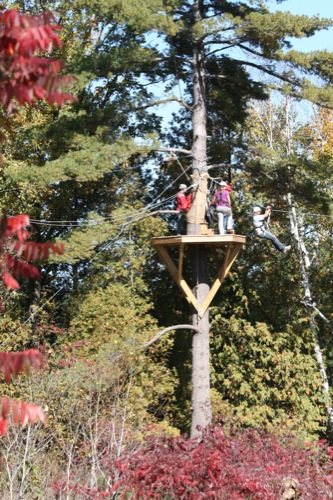
Courtesy Wildman Adventure Resort
Adventure awaits in secluded corners of America’s heartland.
Flying down a river in a raft, swinging through the trees on a zip line, being suspended in the air on a ropes course and fishing on an open lake are only some of the experiences you can have at one of the Midwest’s great adventure parks. There you can connect with nature, explore the great outdoors and find fun in getting a little dirt under your fingernails.
Wildman Adventure Resort
Athelstane and Niagara, Wisconsin
Enjoy days filled with exploration and thrills, and then climb into a warm bed in the same location. Wildman Adventure Resort offers activities at Peshtigo River Outpost and Menominee River Outpost. There are plenty of opportunities to try something new, with whitewater rafting, zip-lining tours and golf.
Fall is the perfect time to go in a sea kayak and enjoy all the beauty the season brings.
“We do it [sea kayaking] on the part of the river that’s dammed up,” said Rebecca Kanzenbach, the resort’s operations manager. “You’ll paddle through and be able to see trees where it used to be forest, and the islands you can paddle around are where you can see wildlife such as eagles.”
The resort offers climbing and rappelling, as well as a high ropes course with “six different routes, and each route has a different aspect to make it easier or more difficult, depending on the climber’s experience,” Kanzenbach said.
All activities are guided, and anyone 12 or older can participate. Half-day trips, such as whitewater rafting, are available twice a day on weekdays in the morning and in the afternoon.
SUP Iowa
Arnolds Park, Iowa
Stand-up paddling (SUP) has been sweeping the nation as the latest fitness craze. The board is a lot like a surfboard, but it’s typically bigger and has a single blade. To move, you use a paddle, so there is no need for waves. This also means you don’t have to be near an ocean to participate.
Sheena Schreck decided to bring the experience to the Midwest when she launched SUP Iowa.
“I was born and raised in Iowa and first did SUP in 2009 on Lake Tahoe,” Schreck said. “Then I bought my board and then bought a second so a friend could come with me. I think it’s an amazing opportunity to bring back to Iowa.”
SUP Iowa offers lessons for all ages and abilities. Classes include beginner, private, semiprivate and groups. The company also offers camps for kids, yoga classes, and rentals for children and adults. SUP Iowa has 19 boards, so rents to groups of 19 or fewer.
The staff can customize a package for larger groups. They can set up relay courses, be booked for special events and help with team-building activities. The official season runs from Memorial Day to Labor Day, but Schreck said they love “SUP-ing” and will continue to offer rentals and services for as long and often as visitors request.











